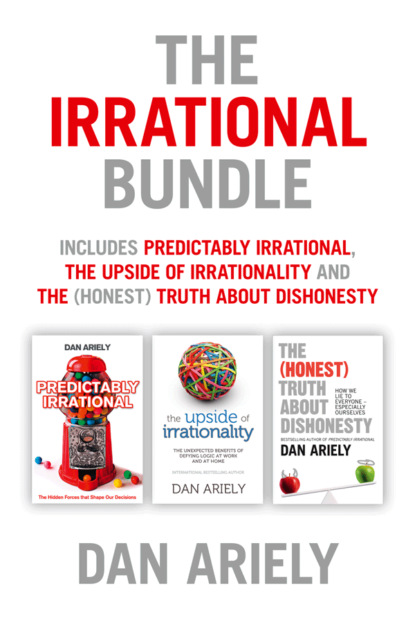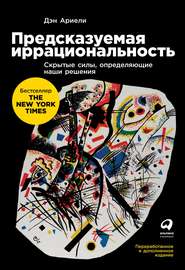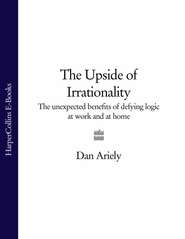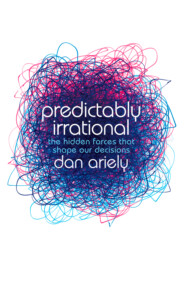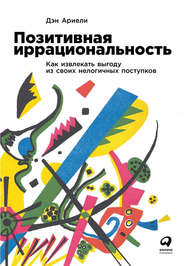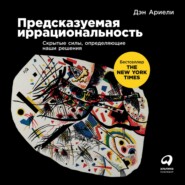По всем вопросам обращайтесь на: info@litportal.ru
(©) 2003-2024.
✖
The Irrational Bundle
Автор
Год написания книги
2018
Настройки чтения
Размер шрифта
Высота строк
Поля
A third set of questions asked about Roy’s likelihood of engaging in behaviors related to unsafe sex. Does a condom decrease sexual pleasure? Would he always use a condom if he didn’t know the sexual history of a new sexual partner? Would he use a condom even if he was afraid that a woman might change her mind while he went to get it?* (#litres_trial_promo)
A few days later, having answered the questions in his “cold,” rational state, Roy met again with Mike.
“Those were some interesting questions,” Roy noted.
“Yes, I know,” Mike said coolly. “Kinsey had nothing on us. By the way, we have another set of experimental sessions. Would you be interested in participating again?”
Roy smiled a little, shrugged, and nodded.
Mike shoved a few pages toward him. “This time we’re asking you to sign the same consent form, but the next task will be slightly different. The next session will be very much the same as the last one, but this time we want you to get yourself into an excited state by viewing a set of arousing pictures and masturbating. What we want you to do is arouse yourself to a high level, but not to ejaculate. In case you do, though, the computer will be protected.”
Mike pulled out the Apple iBook. This time the keyboard and the screen were covered with a thin layer of Saran wrap.
Roy made a face. “I didn’t know computers could get pregnant.”
“Not a chance,” Mike laughed. “This one had its tubes tied. But we like to keep them clean.”
Mike explained that Roy would browse through a series of erotic pictures on the computer to help him get to the right level of arousal; then he would answer the same questions as before.
WITHIN THREE MONTHS, some fine Berkeley undergraduate students had undergone a variety of sessions in different orders. In the set of sessions conducted when they were in a cold, dispassionate state, they predicted what their sexual and moral decisions would be if they were aroused. In the set of sessions conducted when they were in a hot, aroused state, they also predicted their decisions—but this time, since they were actually in the grip of passion, they were presumably more aware of their preferences in that state. When the study was completed, the conclusions were consistent and clear—overwhelmingly clear, frighteningly clear.
In every case, our bright young participants answered the questions very differently when they were aroused from when they were in a “cold” state. Across the 19 questions about sexual preferences, when Roy and all the other participants were aroused they predicted that their desire to engage in a variety of somewhat odd sexual activities would be nearly twice as high as (72 percent higher than) they had predicted when they were cold. For example, the idea of enjoying contact with animals was more than twice as appealing when they were in a state of arousal as when they were in a cold state. In the five questions about their propensity to engage in immoral activities, when they were aroused they predicted their propensity to be more than twice as high as (136 percent higher than) they had predicted in the cold state. Similarly, in the set of questions about using condoms, and despite the warnings that had been hammered into them over the years about the importance of condoms, they were 25 percent more likely in the aroused state than in the cold state to predict that they would forego condoms. In all these cases they failed to predict the influence of arousal on their sexual preferences, morality, and approach to safe sex.
The results showed that when Roy and the other participants were in a cold, rational, superego-driven state, they respected women; they were not particularly attracted to the odd sexual activities we asked them about; they always took the moral high ground; and they expected that they would always use a condom. They thought that they understood themselves, their preferences, and what actions they were capable of. But as it turned out, they completely underestimated their reactions.
No matter how we looked at the numbers, it was clear that the magnitude of underprediction by the participants was substantial. Across the board, they revealed in their unaroused state that they themselves did not know what they were like once aroused. Prevention, protection, conservatism, and morality disappeared completely from the radar screen. They were simply unable to predict the degree to which passion would change them.* (#litres_trial_promo)
IMAGINE WAKING UP one morning, looking in the mirror, and discovering that someone else—something alien but human—has taken over your body. You’re uglier, shorter, hairier; your lips are thinner, your incisors are longer, your nails are filthy, your face is flatter. Two cold, reptilian eyes gaze back at you. You long to smash something, rape someone. You are not you. You are a monster.
Beset by this nightmarish vision, Robert Louis Stevenson screamed in his sleep in the early hours of an autumn morning in 1885. Immediately after his wife awoke him, he set to work on what he called a “fine bogey tale”—Dr. Jekyll and Mr. Hyde—in which he said, “Man is not truly one, but truly two.” The book was an overnight success, and no wonder. The story captivated the imagination of Victorians, who were fascinated with the dichotomy between repressive propriety—represented by the mild-mannered scientist Dr. Jekyll—and uncontrollable passion, embodied in the murderous Mr. Hyde. Dr. Jekyll thought he understood how to control himself. But when Mr. Hyde took over, look out.
The story was frightening and imaginative, but it wasn’t new. Long before Sophocles’s Oedipus Rex and Shakespeare’s Macbeth, the war between interior good and evil had been the stuff of myth, religion, and literature. In Freudian terms, each of us houses a dark self, an id, a brute that can unpredictably wrest control away from the superego. Thus a pleasant, friendly neighbor, seized by road rage, crashes his car into a semi. A teenager grabs a gun and shoots his friends. A priest rapes a boy. All these otherwise good people assume that they understand themselves. But in the heat of passion, suddenly, with the flip of some interior switch, everything changes.
Our experiment at Berkeley revealed not just the old story that we are all like Jekyll and Hyde, but also something new—that every one of us, regardless of how “good” we are, underpredicts the effect of passion on our behavior. In every case, the participants in our experiment got it wrong. Even the most brilliant and rational person, in the heat of passion, seems to be absolutely and completely divorced from the person he thought he was. Moreover, it is not just that people make wrong predictions about themselves—their predictions are wrong by a large margin.
Most of the time, according to the results of the study, Roy is smart, decent, reasonable, kind, and trustworthy. His frontal lobes are fully functioning, and he is in control of his behavior. But when he’s in a state of sexual arousal and the reptilian brain takes over, he becomes unrecognizable to himself.
Roy thinks he knows how he will behave in an aroused state, but his understanding is limited. He doesn’t truly understand that as his sexual motivation becomes more intense, he may throw caution to the wind. He may risk sexually transmitted diseases and unwanted pregnancies in order to achieve sexual gratification. When he is gripped by passion, his emotions may blur the boundary between what is right and what is wrong. In fact, he doesn’t have a clue to how consistently wild he really is, for when he is in one state and tries to predict his behavior in another state, he gets it wrong.
Moreover, the study suggested that our inability to understand ourselves in a different emotional state does not seem to improve with experience; we get it wrong even if we spend as much time in this state as our Berkeley students spend sexually aroused. Sexual arousal is familiar, personal, very human, and utterly commonplace. Even so, we all systematically underpredict the degree to which arousal completely negates our superego, and the way emotions can take control of our behavior.
WHAT HAPPENS, THEN, when our irrational self comes alive in an emotional place that we think is familiar but in fact is unfamiliar? If we fail to really understand ourselves, is it possible to somehow predict how we or others will behave when “out of our heads”—when we’re really angry, hungry, frightened, or sexually aroused? Is it possible to do something about this?
The answers to these questions are profound, for they indicate that we must be wary of situations in which our Mr. Hyde may take over. When the boss criticizes us publicly, we might be tempted to respond with a vehement e-mail. But wouldn’t we be better off putting our reply in the “draft” folder for a few days? When we are smitten by a sports car after a test-drive with the wind in our hair, shouldn’t we take a break—and discuss our spouse’s plan to buy a minivan—before signing a contract to buy the car?
Here are a few more examples of ways to protect ourselves from ourselves:
Safe Sex
Many parents and teenagers, while in a cold, rational, Dr. Jekyll state, tend to believe that the mere promise of abstinence—commonly known as “Just say no”—is sufficient protection against sexually transmitted diseases and unwanted pregnancies. Assuming that this levelheaded thought will prevail even when emotions reach the boiling point, the advocates of “just saying no” see no reason to carry a condom with them. But as our study shows, in the heat of passion, we are all in danger of switching from “Just say no” to “Yes!” in a heartbeat; and if no condom is available, we are likely to say yes, regardless of the dangers.
What does this suggest? First, widespread availability of condoms is essential. We should not decide in a cool state whether or not to bring condoms; they must be there just in case. Second, unless we understand how we might react in an emotional state, we will not be able to predict this transformation. For teenagers, this problem is most likely exacerbated, and thus sex education should focus less on the physiology and biology of the reproductive system, and more on strategies to deal with the emotions that accompany sexual arousal. Third, we must admit that carrying condoms and even vaguely understanding the emotional firestorm of sexual arousal may not be enough.
There are most likely many situations where teenagers simply won’t be able to cope with their emotions. A better strategy, for those who want to guarantee that teenagers avoid sex, is to teach teenagers that they must walk away from the fire of passion before they are close enough to be drawn in. Accepting this advice might not be easy, but our results suggest that it is easier for them to fight temptation before it arises than after it has started to lure them in. In other words, avoiding temptation altogether is easier than overcoming it.
To be sure, this sounds a lot like the “Just say no” campaign, which urges teenagers to walk away from sex when tempted. But the difference is that “Just say no” assumes we can turn off passion at will, at any point, whereas our study shows this assumption to be false. If we put aside the debate on the pros and cons of teenage sex, what is clear is that if we want to help teenagers avoid sex, sexually transmitted diseases, and unwanted pregnancies, we have two strategies. Either we can teach them how to say no before any temptation takes hold, and before a situation becomes impossible to resist; or alternatively, we can get them prepared to deal with the consequences of saying yes in the heat of passion (by carrying a condom, for example). One thing is sure: if we don’t teach our young people how to deal with sex when they are half out of their minds, we are not only fooling them; we’re fooling ourselves as well. Whatever lessons we teach them, we need to help them understand that they will react differently when they are calm and cool from when their hormones are raging at fever pitch (and of course the same also applies to our own behavior).
Safe Driving
Similarly, we need to teach teenagers (and everyone else) not to drive when their emotions are at a boil. It’s not just inexperience and hormones that make so many teenagers crash their own or their parents’ cars. It’s also the car full of laughing friends, with the CD player blaring at an adrenaline-pumping decibel level, and the driver’s right hand searching for the french fries or his girlfriend’s knee. Who’s thinking about risk in that situation? Probably no one. A recent study found that a teenager driving alone was 40 percent more likely to get into an accident than an adult. But with one other teenager in the car, the percentage was twice that—and with a third teenager along for the ride, the percentage doubled again.
To react to this, we need an intervention that does not rely on the premise that teenagers will remember how they wanted to behave while in a cold state (or how their parents wanted them to behave) and follow these guidelines even when they are in a hot state. Why not build into cars precautionary devices to foil teenagers’ behavior? Such cars might be equipped with a modified OnStar system that the teenager and the parents configure in a cold state. If a car exceeds 65 miles per hour on the highway, or more than 40 miles per hour in a residential zone, for example, there will be consequences. If the car exceeds the speed limit or begins to make erratic turns, the radio might switch from 2Pac to Schumann’s Second Symphony (this would slow most teenagers). Or the car might blast the air conditioning in winter, switch on the heat in summer, or automatically call Mom (a real downer if the driver’s friends are present). With these substantial and immediate consequences in mind, then, the driver and his or her friends would realize that it’s time for Mr. Hyde to move over and let Dr. Jekyll drive.
This is not at all far-fetched. Modern cars are already full of computers that control the fuel injection, the climate system, and the sound system. Cars equipped with OnStar are already linked to a wireless network. With today’s technology, it would be a simple matter for a car to automatically call Mom.
Better Life Decisions
Not uncommonly, women who are pregnant for the first time tell their doctors, before the onset of labor, that they will refuse any kind of painkiller. The decision made in their cold state is admirable, but they make this decision when they can’t imagine the pain that can come with childbirth (let alone the challenges of child rearing). After all is said and done, they may wish they’d gone for the epidural.
With this in mind, Sumi (my lovely wife) and I, readying ourselves for the birth of our first child, Amit, decided to test our mettle before making any decisions about using an epidural. To do this, Sumi plunged her hands into a bucket of ice for two minutes (we did this on the advice of our birth coach, who swore to us that the resulting pain would be similar to the pain of childbirth), while I coached her breathing. If Sumi was unable to bear the pain of this experience, we figured, she’d probably want painkillers when she was going through the actual birth. After two minutes of holding her hands in the ice bucket, Sumi clearly understood the appeal of an epidural. During the birth itself, any ounce of love Sumi ever had for her husband was completely transferred to the anesthesiologist, who produced the epidural at the critical point. (With our second child, we made it to the hospital about two minutes before Neta was born, so Sumi did end up experiencing an analgesic-free birth after all.)
LOOKING FROM ONE emotional state to another is difficult. It’s not always possible; and as Sumi learned it can be painful. But to make informed decisions we need to somehow experience and understand the emotional state we will be in at the other side of the experience. Learning how to bridge this gap is essential to making some of the important decisions of our lives.
It is unlikely that we would move to a different city without asking friends who live there how they like it, or even choose to see a film without reading some reviews. Isn’t it strange that we invest so little in learning about both sides of ourselves? Why should we reserve this subject for psychology classes when failure to understand it can bring about repeated failures in so many aspects of our lives? We need to explore the two sides of ourselves; we need to understand the cold state and the hot state; we need to see how the gap between the hot and cold states benefits our lives, and where it leads us astray.
What did our experiments suggest? It may be that our models of human behavior need to be rethought. Perhaps there is no such thing as a fully integrated human being. We may, in fact, be an agglomeration of multiple selves. Although there is nothing much we can do to get our Dr. Jekyll to fully appreciate the strength of our Mr. Hyde, perhaps just being aware that we are prone to making the wrong decisions when gripped by intense emotion may help us, in some way, to apply our knowledge of our “Hyde” selves to our daily activities.
How can we try to force our “Hyde” self to behave better? This is what Chapter 7 is about.
APPENDIX: CHAPTER 5
A complete list of the questions we asked, with the mean response and percentage differences. Each question was presented on a visual-analog scale that stretched between “no” on the left (zero) to “possibly” in the middle (50) to “yes” on the right (100).
TABLE 1
RATE THE ATTRACTIVENESS OF DIFFERENT ACTIVITIES
TABLE 2
RATE THE LIKELIHOOD OF ENGAGING IN IMMORAL BEHAVIORS LIKE DATE RAPE (A STRICT ORDER OF SEVERITY IS NOT IMPLIED)
TABLE 3
RATE YOUR TENDENCY TO USE, AND OUTCOMES OF NOT USING, BIRTH CONTROL
CHAPTER 7
The Problem of Procrastination and Self-Control





